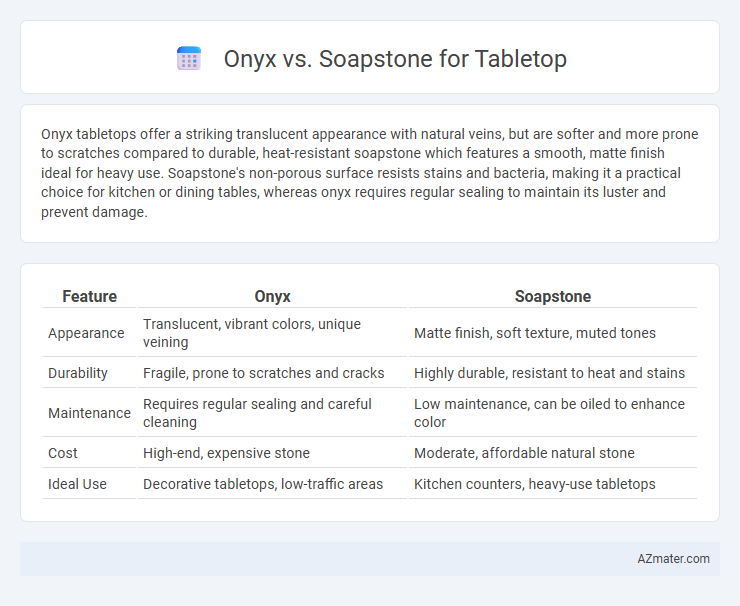Onyx tabletops offer a striking translucent appearance with natural veins, but are softer and more prone to scratches compared to durable, heat-resistant soapstone which features a smooth, matte finish ideal for heavy use. Soapstone's non-porous surface resists stains and bacteria, making it a practical choice for kitchen or dining tables, whereas onyx requires regular sealing to maintain its luster and prevent damage.
Table of Comparison
| Feature | Onyx | Soapstone |
|---|---|---|
| Appearance | Translucent, vibrant colors, unique veining | Matte finish, soft texture, muted tones |
| Durability | Fragile, prone to scratches and cracks | Highly durable, resistant to heat and stains |
| Maintenance | Requires regular sealing and careful cleaning | Low maintenance, can be oiled to enhance color |
| Cost | High-end, expensive stone | Moderate, affordable natural stone |
| Ideal Use | Decorative tabletops, low-traffic areas | Kitchen counters, heavy-use tabletops |
Introduction: Onyx vs Soapstone Tabletops
Onyx and soapstone tabletops both offer unique aesthetic and functional qualities for interior design. Onyx features a translucent, glossy surface with vivid veining, making it ideal for statement pieces, while soapstone presents a matte, smooth finish known for its durability and heat resistance. Choosing between onyx and soapstone depends on balancing visual impact with practical use in tabletops.
Aesthetic Differences Between Onyx and Soapstone
Onyx exhibits a striking translucence with swirling bands of vibrant colors ranging from amber to green, creating a luxurious and dramatic tabletop presence. Soapstone offers a more muted, matte finish with soft gray tones and subtle veining, providing a timeless, natural elegance that complements rustic and modern interiors. The aesthetic difference lies in Onyx's glossy, jewel-like appearance versus Soapstone's understated, smooth texture, influencing the overall ambiance of the space.
Durability and Strength Comparison
Onyx and soapstone differ significantly in durability and strength, with soapstone being notably more resilient due to its dense, non-porous structure and higher resistance to scratches and heat. Onyx, composed of translucent calcite, is softer and more prone to chipping or etching, making it less suitable for heavy use in tabletops. Soapstone's superior hardness rating and natural resistance to acids make it a preferred choice for durable and long-lasting tabletops.
Maintenance Requirements for Both Materials
Onyx tabletops demand careful maintenance due to their porous nature, requiring regular sealing to prevent stains and etching from acidic substances. Soapstone offers superior durability with minimal upkeep, as its non-porous surface naturally resists stains and scratches, needing only occasional oiling to maintain its rich patina. Both materials benefit from gentle cleaning with pH-neutral products, but onyx's delicate composition necessitates more consistent protective measures compared to the hardy, low-maintenance soapstone.
Cost Analysis: Onyx vs Soapstone
Onyx tabletops typically cost between $50 to $150 per square foot, driven by their luxurious appearance and rarity, while soapstone ranges from $70 to $120 per square foot due to its durability and heat resistance. Installation expenses for both materials fluctuate based on thickness and complexity, with onyx generally requiring more skilled labor, increasing total costs by 10-20%. Maintenance costs for onyx are higher because of its porosity and susceptibility to staining, unlike soapstone, which demands minimal upkeep, making it more cost-effective long-term.
Heat and Stain Resistance Properties
Onyx tabletops offer a striking appearance but are relatively soft and prone to heat damage, making them less heat-resistant than soapstone. Soapstone is highly heat-resistant, able to withstand direct contact with hot pots and pans without discoloration or damage. Its dense, non-porous surface also provides superior stain resistance compared to onyx, which can absorb oils and acids more readily.
Environmental Impact and Sustainability
Onyx, a naturally occurring carbonate mineral, requires intensive quarrying processes that generate significant environmental disruption and carbon emissions compared to soapstone, known for its softer composition and lower extraction impact. Soapstone is more sustainable due to its durability, resistance to stains and heat, reducing the need for frequent replacements or repairs, thereby lowering long-term environmental costs. Both materials are recyclable, but soapstone's widespread use in eco-friendly designs highlights its favorable lifecycle footprint in sustainable tabletop applications.
Best Applications for Each Stone
Onyx is best suited for decorative tabletops and low-traffic areas due to its translucent beauty and relative softness, making it ideal for accent pieces or light use. Soapstone excels in kitchen and worktable applications because of its durability, heat resistance, and resistance to stains and scratches. The distinct physical properties of each stone guide their optimal use: onyx offers aesthetic appeal for display surfaces, while soapstone provides functional resilience for everyday work surfaces.
Pros and Cons Summary
Onyx tabletops offer a stunning, translucent surface with unique veining patterns, providing a luxurious and visually striking centerpiece, but they tend to be softer and more prone to scratching and etching compared to other stones. Soapstone scores high for durability and resistance to heat and stains, making it ideal for functional tabletops, yet its softer texture can develop a patina and minor nicks over time. Both materials require regular maintenance, with onyx needing gentle cleaning to prevent damage and soapstone benefiting from periodic oiling to enhance its appearance.
Conclusion: Choosing Between Onyx and Soapstone
Onyx offers striking translucency and vibrant color patterns, making it ideal for decorative tabletops with a luxurious appeal, while soapstone provides superior durability, heat resistance, and a matte finish suited for functional and rustic settings. Soapstone's non-porous nature and ease of maintenance contrast with onyx's fragility and susceptibility to scratching. Selecting between onyx and soapstone ultimately depends on balancing visual impact against practicality and durability for specific tabletop uses.

Infographic: Onyx vs Soapstone for Tabletop
 azmater.com
azmater.com